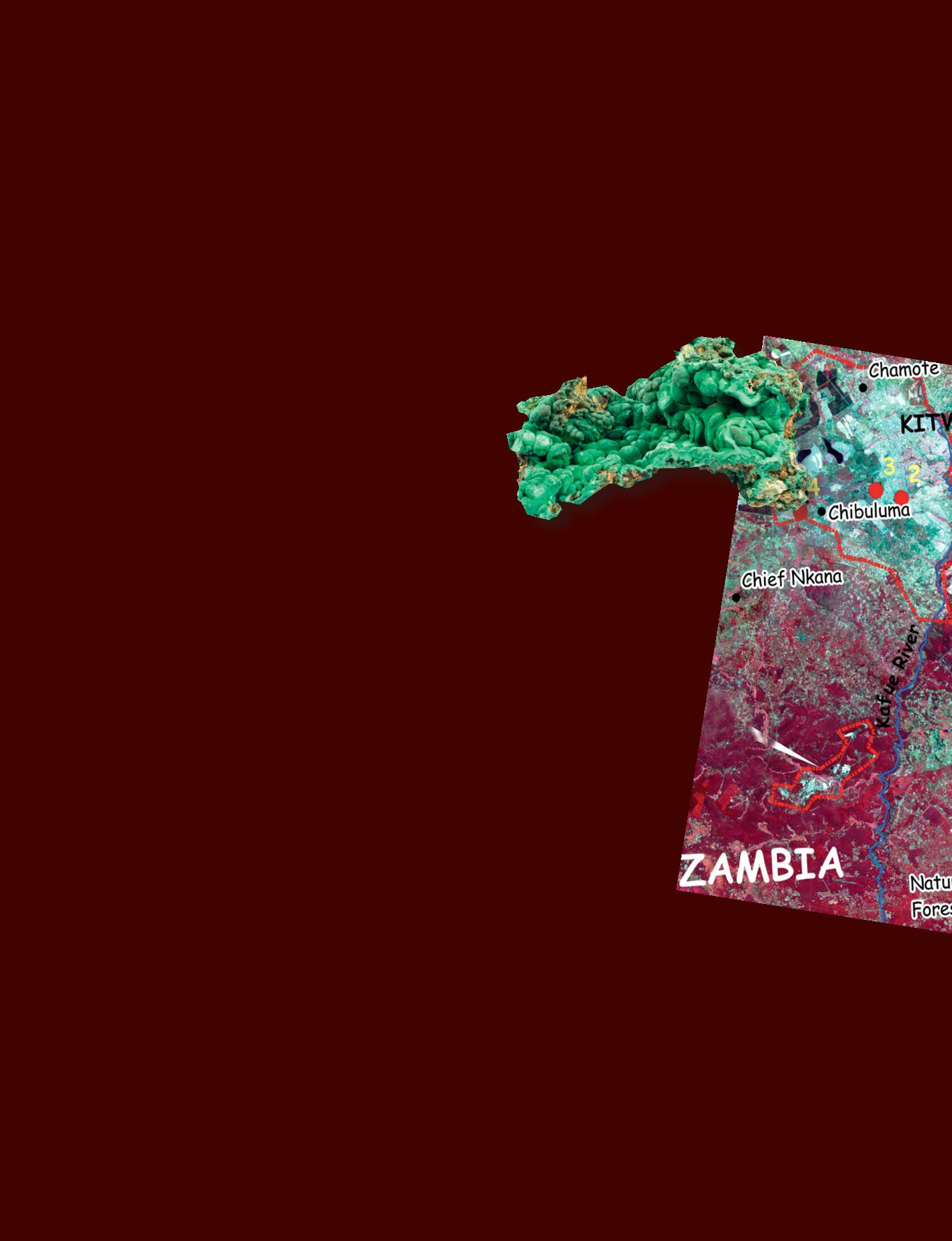
62 - Sustainable Development in Africa & Satellites
Mineral resources mapping
t
Botryoidal malachite (copper carbonate),
Katanga, DRC. Malachite (from the Greek
for mallow, in allusion to its green color) is
a common secondary mineral formed in the
oxidation zone of copper deposits.
©
Geco
, courtesy BRGM
T
he sustainable exploitation and use of Africa’s vast mineral
resources (copper, cobalt, nickel, gold and diamonds) is a
key issue, not only for development of the continent, but
also for the world’s future. In Zambia, it has been contributing
between 60 and 90% of total national foreign exchange earnings
for over 70 years. With about 2 billion tonnes of reserves of copper
ores, the large-scale mining sites on the Zambian Copperbelt
and North-western Province mines provide formal employment
for over 35000 people. The sector generates between 9 and 15%
of the Gross Domestic Product (GDP). But due to the declining
of ore reserves and of average grades, increasing mine depth,
lack of new discoveries and of reinvestment, copper production
and earnings declined from the peak of 755193 tonnes in 1969
to about 250000 in 2000. Since 1991, the Government has
embarked on liberalising the economy so as to move towards
a sustainable balance of payments position. The ultimate goal
is reducing the incidence of poverty and uplifting the living
standard of all Zambians.
The need for good geological data
Driven by world copper demand leading to high prices and
increased production estimated to be over 1 megatonne by
2012, reserves are declining. Zambia should therefore attract
investments to search for more copper ore, its sustainable
exploitation and more importantly in downstream value addition.
The country needs improved infrastructure and services to
support investment, good geological data and up-to-date
geology. The 45% of the country not geologically mapped is not
within existing infrastructure and services such as those along
the railway line. The potential for discovery of new deposits is
higher in the inaccessible areas and therefore use of satellite
data is a must.
For this reason the Geology Department in School of Mines at the
University of Zambia is participating in the EU-funded African-
European Georesources Observation System (AEGOS) project
involving 23 African-European partners. It will provide up to-date
information for all planners in order tomakemeaningful mineral
exploitation investments. Being a first project of its kind, African
representation is of 10 partners but this is expected to rise once
the countries see the benefits of the project. In this regard,
the Universities of Zambia and Lubumbashi are developing a
project on ‘Mineral Resources, Environmental Management
and Geotouristic potential in the DRC - Zambia Copperbelt’. It
will map the environmental impacts of exploitation of copper in
the transboundary border of the two countries and recommend
developing some abandoned mining sites as geotouristic sites.
Also Zambia Integrated Water Resources Management Centre is
involved in the ESA TIGER Project, working with satellite images
such as the ENVISAT ASAR tomapwater resources such as in the
Kafue National Park. Limiting factors exist, like vegetation cover
and lack of skilled human resources, but coverage, repeatability
and prices of images are not necessarily an issue for geological
mapping since geological changes require millions of years.
Inexpensive archived images can be used.
Providing employment
Zambia could play a role in the
US$38 billion worth worldmarket
of copper products through
integration in the copper value
chain, passing from cathode
production to value added
products used in plumbing,
hydraulic and wear by friction
in engineering. Also, copper
sulphate has industrial and
agricultural uses, and in its
high purity form copper is
useful in the electronics
and jewellery industries.
Such downstream manufacturing plants
should be created, so that when mining ceases, Zambia
could import the cathodes from neighbouring countries such as
the DRC and Angola.
This would continue to provide employment and wealth to
sustain the urban development that has resulted from the
mining of copper. A good example is the manufacture of a
jackhammer in the UK during the mining period and which is
still being produced and used in Zambia today.
c
Pr Imasiku Nyambe
Director
Directorate of Research and Graduate Studies
University of Zambia
Lusaka


